Affirmation of Life
Grief and mourning are part of living. Human relationships are life-
Grief
grief
The deep sorrow that people feel at the death of another. Grief is personal and unpredictable.
Grief is the powerful sorrow that an individual feels at a profound loss, especially when a loved one dies. It is deep and personal, an anguish that can overtake daily life.
Video: Bereavement: Grief in Early and Middle Adulthood presents the views of a young-
NORMAL GRIEF Sadness at a loss is normal, even when it leads to unusual actions and thoughts. Grief is manifest in uncontrollable crying, sleeplessness, and irrational and delusional thoughts—
Grief has no distance. Grief comes in waves, paroxysms, sudden apprehensions that weaken the knees and blind the eyes and obliterate the dailiness of life. . . . I see now that my insistence on spending that first night alone was more complicated than it seemed, a primitive instinct . . . There was a level on which I believed that what had happened remained reversible. That is why I needed to be alone. . . . I needed to be alone so that he could come back. This was the beginning of my year of magical thinking.
[Didion, 2005, pp. 27, 32, 33]
When a loved one dies, loneliness, denial, anger, and sorrow come in rapid waves, overtaking normal human needs—
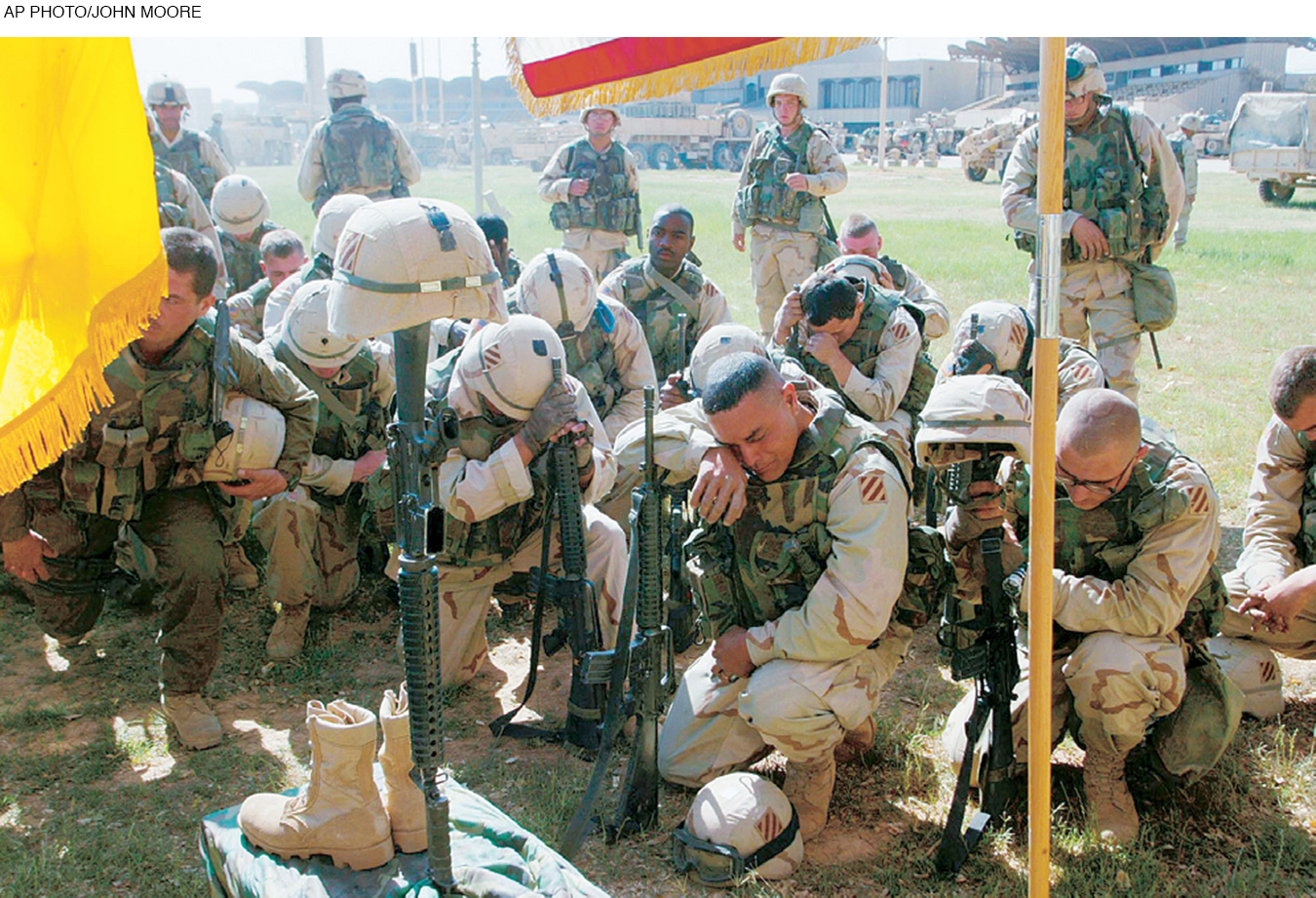
But first, let us recognize that grief is not always normal. In fact, DSM-
COMPLICATED GRIEF In recent times, death has become more private and, for many people, less religious. Emblematic of this change are funeral trends in the United States: Whereas older generations may prefer burial after a traditional funeral, younger generations are likely to prefer a memorial service after cremation.
complicated grief
A type of grief that impedes a person’s future life, usually because the person clings to sorrow or is buffeted by contradictory emotions.
Cremation may seem to be a simpler, more rational way to deal with death, but grief is neither simple nor rational: Decisions about what to do with the ashes after cremation may be fraught with denial and controversy and thus add complexity (Cranwell, 2010). About 10 percent of all mourners experience complicated grief, a type of grief that impedes the person’s future life (Neimeyer & Jordan, 2013).
absent grief
When mourners do not grieve, either because other people do not allow expressions of grief or because the mourners do not allow themselves to feel sadness.
Perhaps surprisingly, one complication is called absent grief, when a bereaved person does not seem to grieve. This is a common first reaction, but if it continues, absent grief can trigger physical or psychological symptoms—
Absent grief may be more common in modern society than it was earlier. The laws of some nations—
As mentioned in Chapter 13, national laws do not accommodate cultural variations within each nation. People who live and work where no one knows their personal lives have no community or public customs to help them grieve. Indeed, for workers at large corporations or students in universities, grief becomes “an unwelcome intrusion (or violent intercession) into the normal efficient running of everyday life” (Anderson, 2001, p. 141). This leads to isolation—

disenfranchised grief
A situation in which certain people, although they are bereaved, are prevented from mourning publicly by cultural customs or social restrictions.
Modern life also increases the incidence of disenfranchised grief, which is “not merely unnoticed, forgotten, or hidden; it is socially disallowed and unsupported” (Corr & Corr, 2013b, p. 135). For instance, many laws rule that only a current spouse or close blood relative may decide on funeral arrangements, disposal of the body, and other matters. This made sense when all adults were close to their relatives, but it may result in “gagged grief and beleaguered bereavement” when, for instance, a longtime friend is excluded (Green & Grant, 2008, p. 275).
Many people are disenfranchised; they feel powerful grief but cannot express it. The deceased’s unmarried lover (of the same or other sex), a divorced spouse, young children, and close friends at work may be prevented by the family, either deliberately or through ignorance. They cannot say goodbye, view the corpse, or participate in the aftermath of death. Parents who lose a fetus or newborn may be disenfranchised by those who say, “You never knew that baby; you can have another.”
incomplete grief
When circumstances, such as a police investigation or an autopsy, interfere with the process of grieving.
Another complication is incomplete grief. Normally grief is a process, intense at first, diminished over time, eventually reaching closure. Customs such as viewing the dead, or throwing dirt on the grave, or scattering ashes all move the process of grief forward, allowing expression and then recovery. However, many circumstances can interfere with this process.
Traumatic death is always unexpected, and that causes denial, anger, and depression to undercut the emotions of grief (Kauffman, 2013). Murders and suicides often trigger police investigations and reporters; inquiries when mourners need to grieve instead of answering questions.
An autopsy may prevent closure if the griever believes that the body will rise or that the soul does not immediately leave the body. Inability to recover a body, as with soldiers who are missing in action or with victims of a major flood or fire, may prevent grief from being expressed and thereby hinder completion.
After natural or human-
Mourning
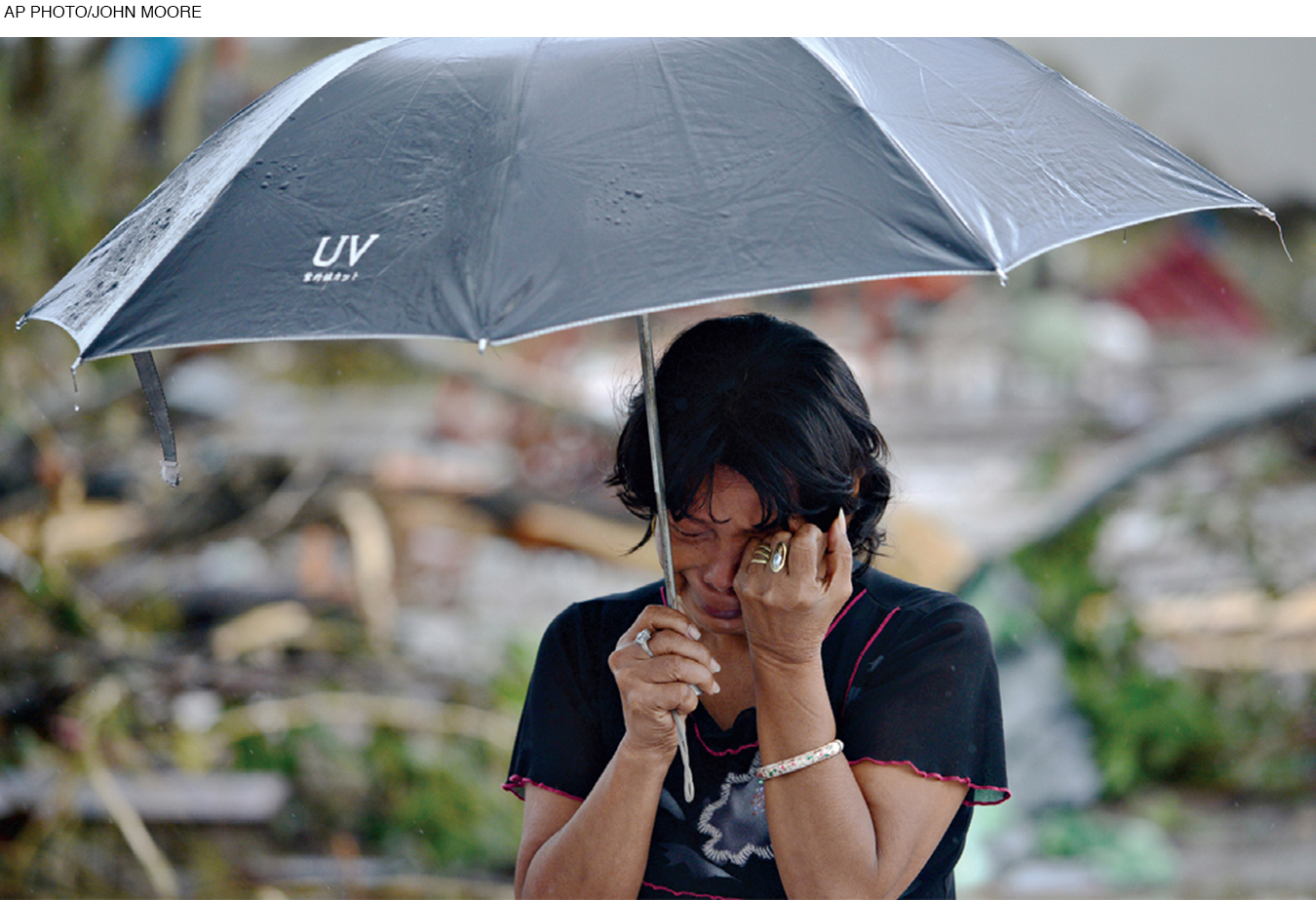
mourning
The ceremonies and behaviors that a religion or culture prescribes for people to express their grief after a death.
Grief splinters people into jumbled pieces, making them vulnerable. Mourning reassembles them, making them whole again and able to rejoin the larger community. To be more specific, mourning is the public and ritualistic expression of bereavement, the ceremonies and behaviors that a religion or culture prescribes to honor the dead.
HOW MOURNING HELPS Mourning is needed because, as you just read, the grief-
Physical and mental health dips in the recently bereaved, and the rate of suicide increases. The death of a child is particularly hard on the parents, who either distance themselves from each other or may become closer. Shared mourning rituals are one way families help each other.
A large study in Sweden of children who had experienced the death of a brother or sister found that in early and middle adulthood they were more likely to die than other Swedes. That was true even if their siblings had not killed themselves, but if they had, survivors were three times as likely to commit suicide as other Swedish adults of the same age and background (Rostila et al., 2013).
All the research shows that the mourning process is particularly needed by survivors after suicide. Unfortunately, mourning is too often complicated and private after suicide, because survivors tend to blame themselves or feel angry at the deceased.
Another group of people who are particularly likely to need bereavement counseling are the very old (Neimeyer et al., 2015). Sometimes younger people assume that older people expected a friend or spouse to die and thus should not experience complicated grief. That assumption is ageist. As already noted, death is more easily accepted by the elderly, but that does not mean that mourning does not occur.
Customs are designed to help people move from grief toward reaffirmation (Harlow, 2005; Corr & Corr, 2013b). For this reason, eulogies emphasize the dead person’s good qualities; people who did not personally know the deceased person attend wakes, funerals, or memorial services to help comfort the survivors.
If the dead person was a public figure, mourners may include thousands, even millions. They express their sorrow to one another, stare at photos and listen to music that remind them of the dead person, weep as they watch funerals on television. Mourners often pledge to affirm the best of the deceased, forgetting any criticisms they might have had in the past.
One function of mourning is to allow public expression of grief to channel and contain private grief. Examples include the Jewish custom of sitting shiva at home for a week, or the three days of active sorrow among some Muslim groups, or the 10 days of ceremonies beginning at the next full moon following a Hindu death.
Memories often return to the immediate relatives and friends on the anniversary of a death, so cultures include annual rituals such as visiting a grave or lighting a candle in memory. Many people who have distanced themselves from the religious rituals of their community find solace in returning to them when a person dies (Rosenblatt, 2013).
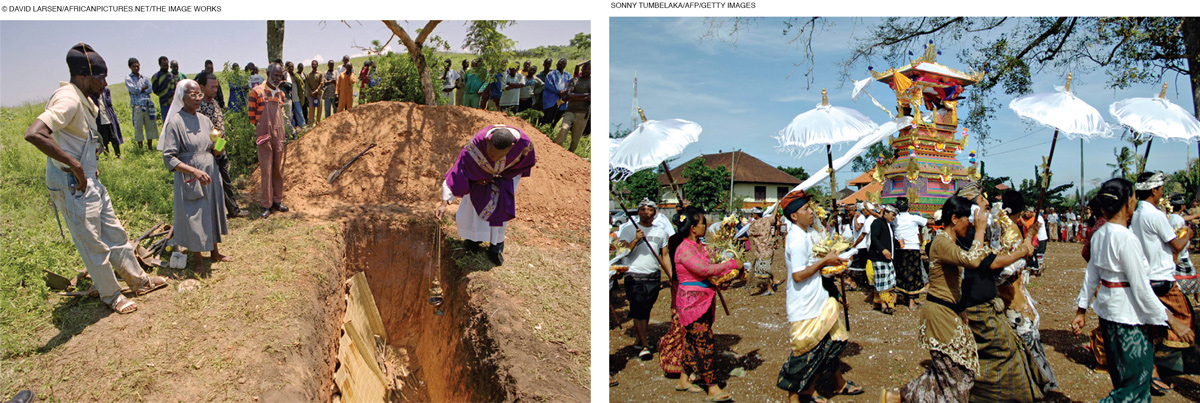
As you have read, beliefs about death vary a great deal, and beliefs affect mourning rituals. Some religions believe in reincarnation—
Mourners do whatever they believe will help the deceased. Certain prayers may be repeated to ensure a good afterlife. Some religions contend that the spirits of the dead remain on Earth and affect those still living; mourners who believe this typically provide food and other comforts to the dead so that their spirits will be benevolent. Some religions hold that the dead live on only in memory: The custom may be to name a baby after a dead person or to honor the dead on a particular memorial day.
The Western practice of building a memorial, dedicating a plaque, or naming a location for a dead person is antithetical to some Eastern cultures. Indeed, some Asians believe that the spirit should be allowed to leave in peace, and thus all possessions, signs, and other evidence of the dead are removed after proper prayers.
This created a cultural clash when terrorist bombs in Bali killed 38 Indonesians and 164 foreigners (mostly Australian and British). The Indonesians prayed intensely and then destroyed all reminders; the Australians raised money to build a memorial (de Jonge, 2011). The Indonesian officials posed many obstacles that infuriated the Australians, and the memorial was not built. Neither group understood the deep emotions of the other.
In recent decades, many people everywhere have become less religiously devout, and mourning practices are less ritualized. Has death then become a source of despair, not hope? Maybe not. People worldwide become more spiritual when confronted with death (Lattanzi-
Psychologists contend that human cognition naturally leads to belief in life after death (Pereira et al., 2012). If societies undermine the expression of grief and the customs of mourning, that may interfere with individual and community health.
THINK CRITICALLY: Do you think current wars are fueled by a misguided impulse to assign blame?
PLACING BLAME AND SEEKING MEANING A common impulse after death is for the survivors to assess blame—
For public tragedies, nations accuse one another. Blame is not rational or proportional. For instance, outrage at the assassination of Archduke Francis Ferdinand of Austria by a Serbian terrorist in 1914 provoked a conflict between Austria and Serbia—
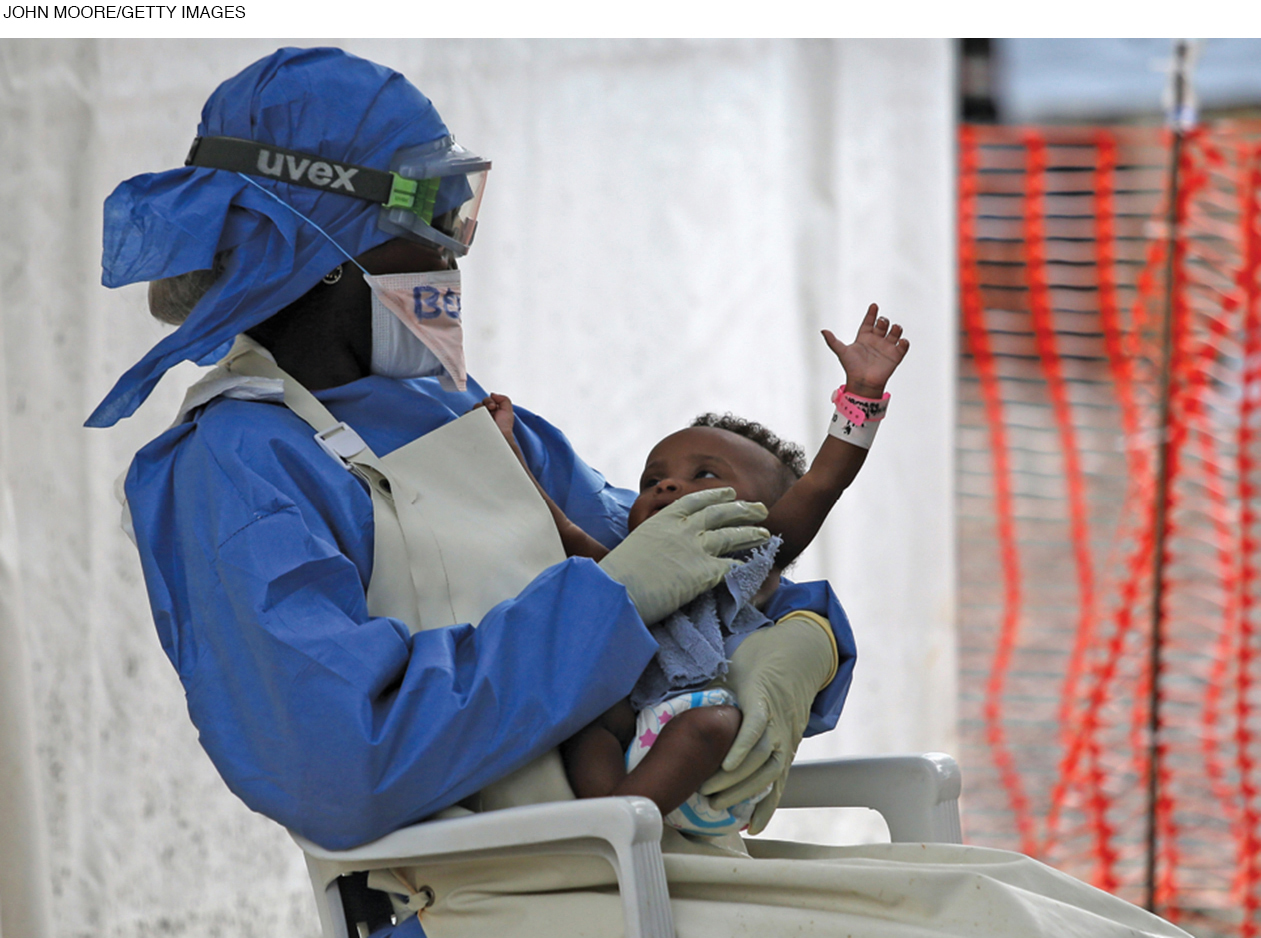
As you remember, denial and anger appear first on Kübler-
In some cases, this search starts with preserving memories: Displaying photographs and personal effects and telling anecdotes about the dead person are central to many memorial services. With major disasters, survivors often seek a goal to honor the memory of the dead. Many people believe that Israel would not have been created without the Holocaust, or that marriage and love between same-
Mourners may be helped by strangers who have experienced a similar loss. This explains groups of parents of murdered children, of mothers whose teenagers were killed by drunk drivers, of widows of firefighters who died at the World Trade Center on September 11, 2001, of relatives of passengers who died in the same plane crash, and many more.
Mourners sometimes want strangers to know about a death. Pages of paid obituaries are found in every major newspaper, and spontaneous memorials (graffiti, murals, stuffed animals, flowers) appear in public spaces, such as at a spot on a roadside where a fatal crash occurred. This practice was once discouraged, but no longer. Authorities realize that public commemoration aids grief and mourning, building community: Public markers of bouquets and so on are dismantled only when flowers fade and time has passed (Dickinson & Hoffmann, 2010).
Organizations that combat a particular problem (such as breast cancer or handguns) find their most dedicated donors, marchers, and advocates among people who have lost a loved one to that specific danger. When someone dies, survivors often designate a charity that is connected to the deceased. Then mourners contribute, and the death has led to some good.
Another way people find meaning in death is to gather in vigils, rallies, or protests, typically seeking some particular redress:
When a truck killed a 9-
year- old in Germany, neighbors and strangers blocked the street for days until new safeguards were installed (Rulfs, 2011). When a cyclist was killed by a car, other cyclists erected “ghost bikes” and ritualistically raised their bicycles, leading to a plethora of new bike lanes in New York City (Dobler, 2011).
When a White racist killed nine members of a prayer group in Charleston, South Carolina, the legislature voted to take down the Confederate flag from the State Capitol grounds.
The impulse to assign blame and seek meaning is powerful but not always constructive. Revenge may arise, leading to long-
Diversity of Reactions
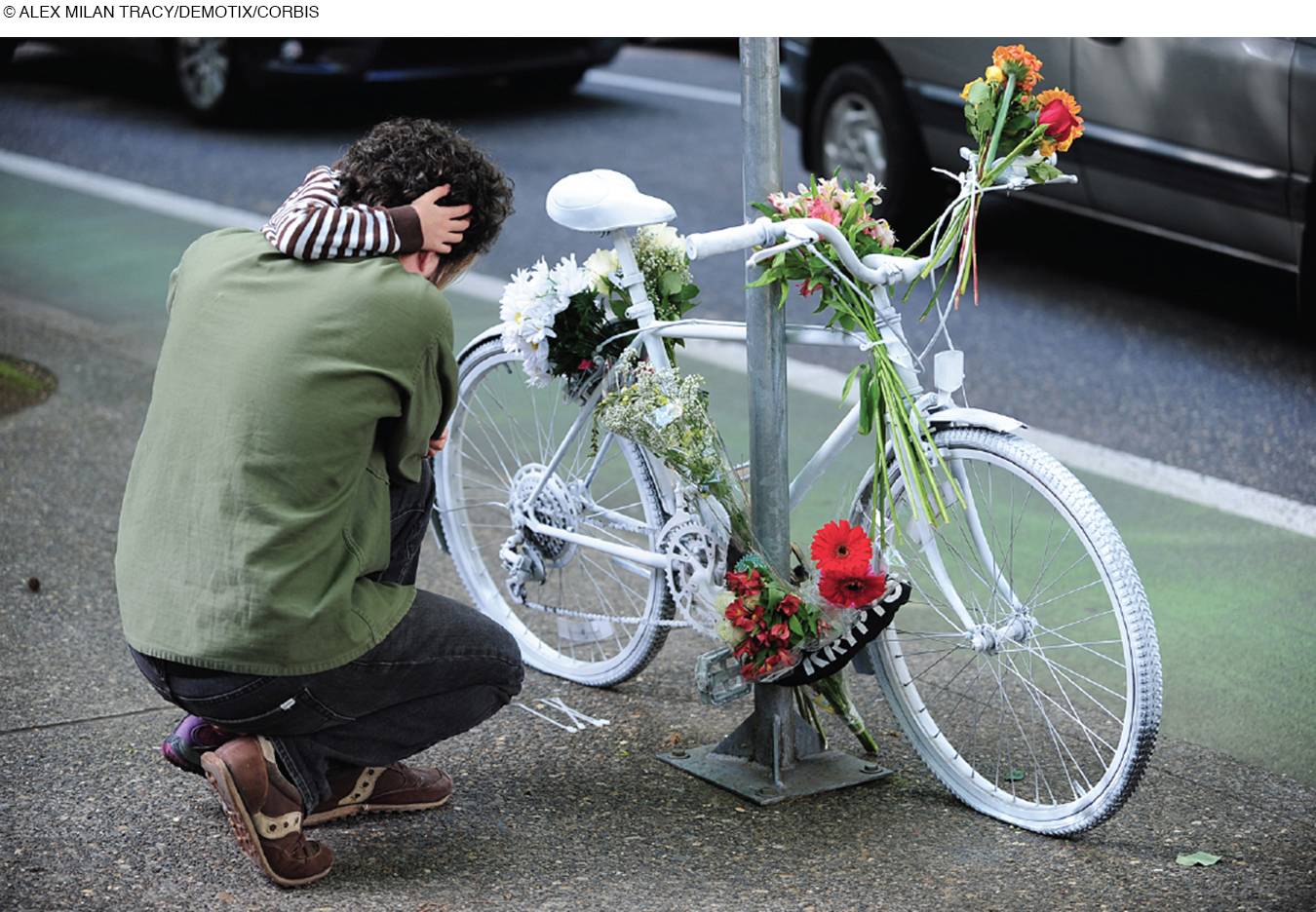
As you see, how someone deals with bereavement depends on the customs and attitudes of their community. Particulars vary. For example, mourners who keep the dead person’s possessions, talk to the deceased, and frequently review memories are notably less well adjusted than other mourners 18 months after the death if they live in the United States but are better adjusted if they live in China (Lalande & Bonanno, 2006).
normal grief
The usual response to a loss. Initial sadness and then recovery are normal.
Past experiences affect bereavement. Children who lost their parents might be more distraught decades later when someone else dies. Attachment history matters (Stroebe et al., 2010). Older adults who were securely attached as children may be more likely to experience normal grief; those whose attachment was insecure-
Reaffirmation does not mean forgetting; continuing bonds are evident years after death (Stroebe et al., 2012). Such bonds may help or hinder reaffirmation, depending on the past relationship between the individuals and on the circumstances of the death.
Although in Western nations hallucinations (seeing ghosts, hearing voices) are a sign of complicated grief, ongoing memories and thoughts of the dead person as a role model are “linked to greater personal growth” (Field & Filanosky, 2010, p. 24). Often survivors write letters or talk to the deceased person, or consider events—
In Video: Bereavement and Grief: Late Adulthood, people discuss their experiences with the loss of beloved family members and friends—
Bereavement theory once held that mourners should grieve and then move on and realize that the dead person is gone forever. It was thought that if this progression did not take place, pathological grief could result, with the person either not grieving enough (absent grief) or grieving too long (incomplete grief). Current research finds a much wider variety of reactions (Rubin et al., 2012), with continuing bonds a normal occurrence.
A VIEW FROM SCIENCE
Resilience After a Death
Earlier studies overestimated the frequency of pathological grief. For obvious reasons, scientists usually began research on mourning with mourners—
Furthermore, psychologists often treated people who had difficulty dealing with a death. Some patients experienced absent grief; others felt disenfranchised grief; some were overcome by unremitting sadness many months after the loss; still others could not find meaning in a violent, sudden, unexpected death. All these people were likely to consult therapists, who helped them while publishing descriptions of the problems and solutions.
We now know that personality has a major affect on grief and mourning (Boyraz et al., 2012). Pathological mourners are not typical. Almost everyone experiences several deaths over a lifetime—
The variety of reactions to death was evident in a longitudinal study that began by assessing thousands of married older adults in greater Detroit. Over several years, 319 became widows or widowers. Most were reinterviewed at 6 and 18 months after the death of their spouse, and about one-
General trends were evident. Almost all the widows and widowers idealized their past marriages, remembering them more positively after the death than they experienced them at the first interview, years before the death. This idealization is a normal phenomenon that other research finds connected to psychological health, not pathology (O’Rourke et al., 2010). After the death, many thought of their spouse several times each day. With time, such thoughts became less frequent, as expected with mourning.
This longitudinal study found notable variations. Four types of responses were evident (Galatzer-
Sixty-
six percent were resilient. They were sad at first, but six months later they were about as happy and productive as they had been before the death. Fifteen percent were depressed at every assessment, before as well as years after the death. If this research had begun only after the death, it might seem that the loss caused depression. However, the pre-
loss assessment suggests that these people were chronically depressed, not stuck in grief. Ten percent were less depressed after the death than before, often because they had been caregivers for their seriously ill partners.
Nine percent were slow to recover, functioning poorly at 18 months. By four years after the death, however, they functioned almost as well as they had before.
The slow recovery of this fourth group suggests that some of them experienced complicated grief. Note, however, that they were far from the majority of the participants.
Many studies show that grief and then recovery are the usual pattern, with only about 10 percent (here 9 percent) needing professional help to deal with a death. A person’s health, finances, and personality all contribute to postmortem reactions.
Crucial are the person’s beliefs before the death (Mancini et al., 2011). If someone tends to have a positive perspective, believing that justice will prevail and that life has meaning, then the death of a close family member may deepen, not weaken, those beliefs. Depression is less likely if a person has already accepted the reality of death.
Practical Applications
The research suggests that many people experience powerful, complicated, and unexpected emotions when death occurs. To help the griever, a friend should listen and sympathize, never implying that the person is either too grief-
A bereaved person might or might not want to visit the grave, light a candle, cherish a memento, pray, or sob. Whatever the action, he or she may want to be alone or may want company. Those who have been taught to bear grief stoically may be doubly distressed if a friend advises them to cry but they cannot. Conversely, those whose cultures expect loud wailing may resent it if they are urged to hush.
Even absent grief—
As you see, assumptions might be inaccurate; people are much more varied than simple explanations of grief might suggest. One researcher cited an example of a 13-
It would have been easy to assume that she was afraid of dying on the street, and to arrange for a friend to accompany her on her way to school. But careful listening revealed the real reason she stayed home: She worried that her depressed mother might kill herself if she were left alone (Crenshaw, 2013). To help the daughter, the mother had to be helped.
No matter what fears arise, what rituals are followed, or what grief entails, the result of mourning may be to give the living a deeper appreciation of themselves and others. In fact, a theme frequently sounded by those who work with the dying and the bereaved is that death leads to a greater appreciation of life, especially of the value of intimate, caring relationships.
George Vaillant is a psychiatrist who studied a group of men from the time they were Harvard students through old age. He writes this about funerals: “With tears of remembrance running down our cheeks. . . . Remembered love lives triumphantly today” (Vaillant, 2008, p. 133).
It is fitting to end this Epilogue, and this book, with a reminder of the creative work of living. As first described in Chapter 1, the study of human development is a science, with topics to be researched, understood, and explained. But the process of living is an art as well as a science, with strands of love and sorrow woven into each person’s unique tapestry. Death, when it leads to hope; dying, when it is accepted; and grief, when it fosters affirmation—
WHAT HAVE YOU LEARNED?
Question 16.23
1. What is grief, and what are some of its signs?
Grief is the powerful sorrow one feels after the death of another. Signs include crying, sleeplessness, delusional thoughts, loneliness, denial, anger, and sorrow. However, grief is highly personal and can manifest itself in many ways.
Question 16.24
2. List three types of complicated grief. Why is each type considered “complicated”?
Absent grief is that in which mourners do not or cannot grieve. Disenfranchised grief is that in which some people, even though they are bereaved, are prevented from participating in mourning. Incomplete grief is that in which circumstances interfere with or delay the process of grieving. All three types of grief are considered “complicated” because they impede the person’s future life, usually because he or she clings to sorrow or is buffeted by contradictory emotions.
Question 16.25
3. What are the differences among grief, mourning, and bereavement?
Grief is the intense sorrow felt after someone dies. Bereavement is the period of grief following a loss. Mourning is the public or ritualistic expression of bereavement, meant to move survivors from a place of loss to reaffirmation.
Question 16.26
4. How can a grieving person find meaning in death?
A grieving person may find meaning in death through engaging in political protests or connecting to causes aimed at improving life for others (for example, joining efforts to end gun violence or drunk driving or to find a cure for cancer), or in reflecting on and sharing the impact that the deceased had on his or her own life.
Question 16.27
5. How might reactions such as talking to the deceased make it both easier and more difficult to adjust to the death of a loved one?
Talking to a deceased loved one is one way of creating a continuing bond, though how much such actions help a person deal with grief may be dependent on culture. In China, talking to a deceased person appears to help the healing process; in the United States, it may actually hinder it.
Question 16.28
6. If a person still feels a loss six months after a death, is that pathological?
While most people are about as happy and productive six months after a death as they were before the death occurred, current research highlights a diversity of reactions after death. Research also points to the importance of knowing about a grieving person’s psychological history when analyzing his or her response to grief.
Question 16.29
7. What should friends and relatives remember when helping someone who is grieving?
Those close to a grieving person should remember that grief involves a variety of complex and powerful emotions, and that there is no one “correct” way to grieve. It is important to listen and sympathize and not to judge, as individuals exhibit a diversity of responses to a loved one’s death.